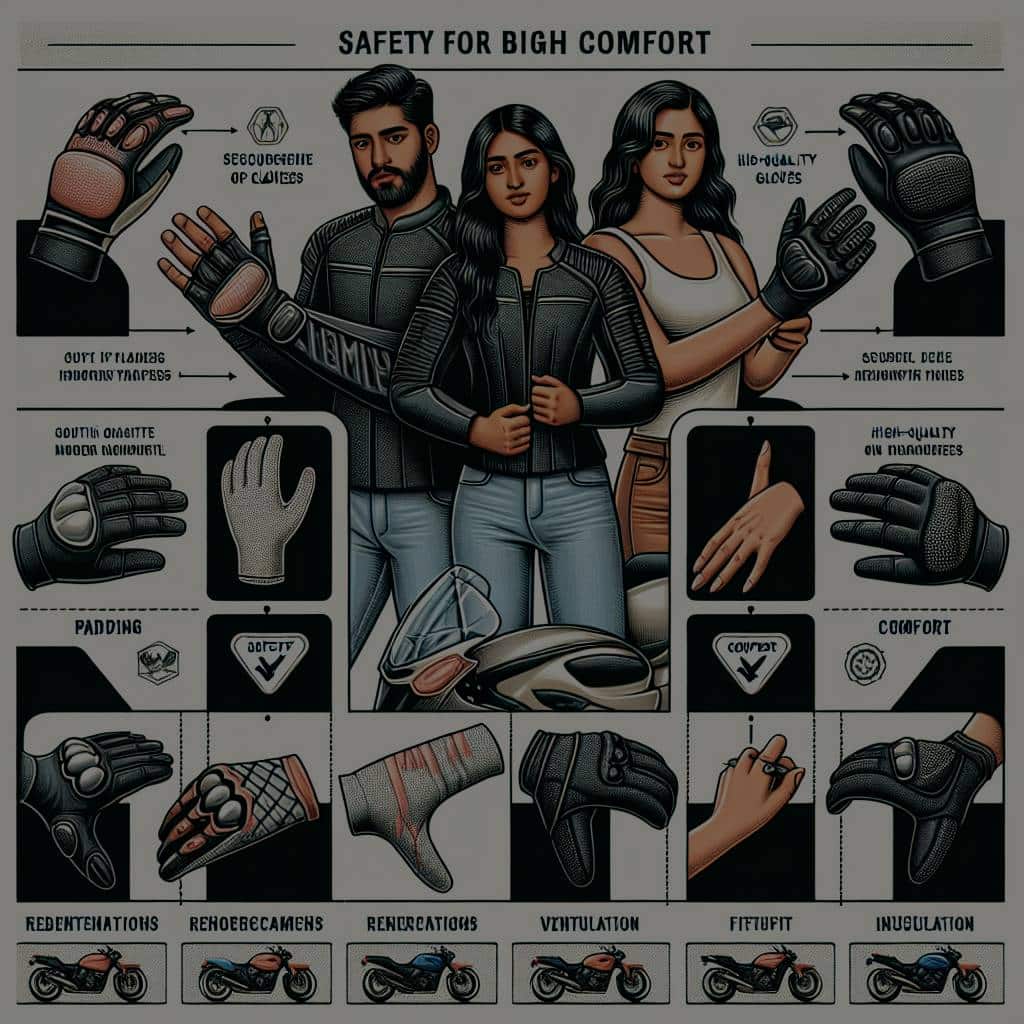How to Choose the Right Motorcycle Gloves for Both Safety and Comfort?

Motorcycle riding is an exhilarating experience, one that brings a sense of freedom and adventure. But, like any other activity, it comes with inherent risks. While helmets are often given the most attention when it comes to safety gear, the importance of a good pair of motorcycle gloves cannot be overstated.
Your hands are one of the most vulnerable parts of your body when riding a motorcycle, and they also play a crucial role in controlling your bike. Hence, having the right pair of gloves offering both safety and comfort is essential.
In the same genre : How to Calibrate the Steering Angle Sensor in a BMW M3 After Alignment?
In this comprehensive guide, we will discuss the key considerations when selecting the best motorcycle gloves. We will explore factors such as fit, materials, features, and more.
Understanding the Importance of a Good Fit
First and foremost, properly fitting gloves are a critical aspect of both comfort and safety. Ill-fitting gloves can cause discomfort or loss of control, both of which can compromise your safety while riding.
Topic to read : Can You Reduce Brake Dust on an Audi Q7 with Ceramic Brake Pads?
Gloves that are too large can slip or fail to provide adequate grip, while those that are too tight can cause numbness or restricted movement. Moreover, the dimensions of the glove should correspond to the size of your hand, including the length of your fingers and the width of your palm.
To get the most accurate fit, measure your hand and check the sizing chart of the brand you’re considering. Keep in mind that sizes may vary between different brands. Also, remember that leather gloves will stretch over time, so they should be snug when you first wear them.
Choosing the Right Materials for Your Gloves
Motorcycle gloves are made from a variety of materials, each offering distinct advantages and disadvantages. Leather and textile are the most common materials used.
Leather gloves are preferred by many riders due to their superior protection and durability. They are highly resistant to abrasion, offering excellent protection in case of a slide or fall. However, leather might not be the best choice for summer riding or wet conditions, as it can get hot and is not naturally waterproof.
On the other hand, textile gloves offer more versatility. They are typically lighter, more breathable, and often come with waterproof features. However, they might not provide the same level of protection as leather gloves.
Some gloves also incorporate both materials, offering a balance between protection, comfort, and versatility. They often feature leather in high-impact areas for protection and textile in other areas for breathability and flexibility.
Key Features to Look for in Motorcycle Gloves
Motorcycle gloves come with a wide array of features tailored to different riding conditions and preferences. These features can significantly impact the glove’s level of safety and comfort.
For safety, look for gloves with reinforced palms and knuckle protection. These features offer an additional level of protection in case of a fall. Some gloves also have touchscreen compatibility, allowing you to operate your phone or GPS without taking them off, which can enhance safety and convenience.
Furthermore, for comfort, check for gloves with ventilation features, especially if you ride in hot weather. Gloves with adjustable straps can also help you achieve a perfect fit, enhancing both comfort and safety.
Considerations for Summer and Waterproof Gloves
If you regularly ride in hot weather, you should consider summer gloves. These gloves are designed to be breathable and lightweight, keeping your hands cool and dry. They often feature mesh or perforated leather for improved airflow.
Conversely, if you ride in wet conditions, waterproof gloves are a must. These gloves typically feature a waterproof membrane and are often made from textile materials. However, they should also be breathable to prevent your hands from getting sweaty.
Checking the Safety Level of Your Gloves
Lastly, it’s essential to check the safety level of your gloves. Motorcycle gloves should meet certain safety standards to ensure they provide adequate protection.
In the European Union, for example, motorcycle gloves are considered personal protective equipment and must comply with the EN 13594 standard. This standard evaluates various aspects of the glove, such as abrasion resistance, seam strength, and impact protection.
In the United States, there’s no specific standard for motorcycle gloves. Nevertheless, it’s always a good idea to look for gloves that meet or exceed European standards. Also, reputable brands usually provide detailed information about the safety features and protective elements of their gloves.
In conclusion, choosing the right motorcycle gloves involves considering various factors such as fit, materials, features, and safety standards. Remember, the best gloves for you will depend on your specific needs, preferences, and riding conditions. So, take the time to understand these aspects and make an informed decision to ensure both safety and comfort when you ride.
Picking the Right Winter or Heated Gloves
As winter approaches, a good pair of winter or heated gloves becomes an essential part of your motorcycle gear. These gloves are designed to keep your hands warm and prevent frostbite, which can be a serious concern during the cold months.
Winter gloves are typically made of leather or textile and have an additional insulation layer to conserve heat. Some winter gloves also offer waterproof features, which can be beneficial if you ride in snow or rain. However, they can be bulky, which might restrict your movement and affect your control of the bike.
On the other hand, heated gloves incorporate heating elements that are either battery-powered or connected to the motorcycle’s electrical system. They offer superior warmth compared to regular winter gloves, and some models allow you to adjust the heat level for optimal comfort. However, they are typically more expensive and require proper care to ensure their longevity.
Regardless of the type of gloves you choose, make sure they fit well and offer adequate protection. Gloves that are too tight can restrict blood flow and make your hands cold, while gloves that are too loose could let cold air seep in. Also, check for gloves with a gauntlet design or extended cuffs, which can provide extra warmth by covering a portion of your wrist and preventing cold air from entering your jacket.
The Significance of a Short Cuff and Gore-Tex in Gloves
Another important consideration when choosing the right motorcycle gloves is the type of cuff and the use of technologies such as Gore-Tex.
Short cuff gloves are often chosen for their comfort and ease of use. They are typically lighter and allow for more maneuverability, making them a popular choice for city riding and short trips. However, they may not provide as much protection as gloves with a longer cuff, especially in the wrist area.
On the other hand, Gore-Tex is a membrane used in various motorcycle gear, including gloves. It offers excellent waterproofing capabilities while also being breathable. This means that even in wet conditions, Gore-Tex gloves can keep your hands dry without causing them to become sweaty. This can enhance both your comfort and grip, ensuring safer rides.
But remember, just because a pair of gloves has Gore-Tex or a short cuff doesn’t mean they’re the best option for you. Always consider your specific needs, the type of riding you do, and the weather conditions you typically encounter before making your decision.
Conclusion
In summary, choosing the right motorcycle gloves is a multifaceted decision that requires careful consideration. From ensuring a good fit to picking the right material, from understanding the importance of safety features to knowing when to opt for summer or waterproof gloves, each aspect plays a crucial role in your overall riding experience.
For winter rides, opt for insulated gloves or heated ones, keeping in mind comfort and functionality. Don’t overlook the significance of cuff length and technologies like Gore-Tex in enhancing your comfort and protection.
Always remember, while the best motorcycle gloves will offer a high protection level, they should also be comfortable, suit your riding conditions, and meet safety standards. Having the right pair of gloves will not only enhance your motorcycle riding experience but also ensure your safety on the road. So, take the time to understand these considerations and make an informed choice. Your hands, after all, are your primary connection to your bike. Protect them well!
